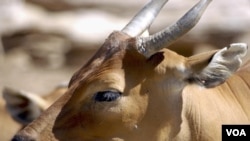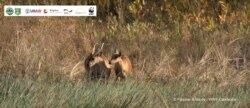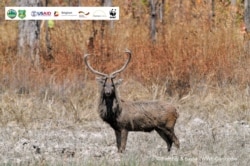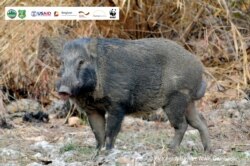Deep in the deciduous tropical forests on the Srepok River banks, Bun Tropin has a routine as he stations himself at the Mereuch Base for the armed forest rangers of Cambodia’s Ministry of the Environment.
The base has a long history of combat dating to the pivotal 1954 Battle of Dien Bien Phu and the Vietnam War, given its location at the midpoint of the Ho Chi Minh Trail, the route communist-led North Vietnam used for sending weapons, manpower, ammunition and other supplies to their supporters in South Vietnam.
But a film produced in 1951 by American zoologist Charles Wharton captured images of armies of graceful banteng and other hoofed mammals, or ungulates, that occupied the area in such numbers that they seem to appear in every frame.
Today, the Mereuch Base serves as a staging area for protecting one of Cambodia’s last remaining natural reserves.
In mid-January, two Voice of America journalists received rare access to tour Mereuch and the sanctuary’s two other bases in a well-choreographed and escorted trip that included about 30 other reporters. Guides told them to not wander because of cluster bombs and other unexploded ordnance in the area.
But Bun Tropin, 27, a World Wildlife Fund (WWF) biodiversity research assistant, knows his way around the restricted sanctuaries in Mondulkiri province because he manages more than 200 camera traps as part of the conservation group’s effort to capture evidence of the presence of wildlife.
Bun Tropin and his team guided the journalists through chest-high grasses to check the cameras installed through the areas.
“When you trek like this, you hardly see any of those bantengs, elephants, tigers and others,” the soft-spoken Bun Tropin told VOA Khmer. “But each time I spot them on camera, I am always wowed. Each time, I just could not take my eyes off them.”
Drastic declines
WWF Cambodia released a report on January 15 saying the ungulate populations in two sanctuaries – Srepok and the neighboring Phnom Prich – had seen a drastic 10-year decline.
The estimated banteng population plummeted by 72%, from about 3,013 in 2010 to just 856 in 2020, within both sanctuaries, which have a combined area of 5,955 square kilometers – slightly larger than Brunei Darussalam.
The population of red muntjacs, also known as barking deer, had declined to about 3,350 in 2020, half the number that had been found in 2010.
“The poaching threat, particularly in the form of snaring, in the two protected sites in the [easter plain landscape] has grown by two orders of magnitude during this monitoring period, indicating that the current level of protected area management and law enforcement efforts are no longer sufficient to tackle the threats effectively,” reads the 86-page report covering the years 2010-2020 that was endorsed by the Ministry of Environment.
Between the late 1960s and the early 1990s, Cambodia’s total banteng population fell by 95%, according to the International Union for Conservation of Nature (IUCN).
In the neighboring Keo Seima Wildlife Sanctuary, the Wildlife Conservation Society (WCS), another conservation group, also documented a dramatic drop in ungulate population over the past 10 years.
"Five out of six monitored ungulate species either show significant population declines or have been assessed by experts as being in decline within [Keo Seima Wildlife Sanctuary]," the WCS said in the report released in September 2020.
Seng Teak, director of WWF Cambodia, said the findings were “concerning,” citing the ongoing hazards of habitat losses, poaching and snares.
“If the snares remain throughout in the forest, there’s a chance forests of the future won’t have any wildlife,” he told VOA Khmer.
A regulatory overhaul introduced in 2016 was designed to distinguish between the overlapping authority of Cambodia’s Ministry of Agriculture’s Forestry Administration and the Ministry of Environment has been implemented.
The Forestry Administration oversees economic land concession planning. The Ministry of Environment protects vast biodiverse areas and wildlife sanctuaries with an embattled crew of armed and uniformed rangers; there are only 51 Environment Ministry rangers in the two preserves, and 1,200 rangers throughout Cambodia. Their numbers are unlikely to increase soon due to austerity measures imposed as combatting the coronavirus pandemic consumes the national budget.
Yet the mountainous province is preparing to welcome a new airport investment, more tourists and more new residents to areas that need protection.
Powerful business interests
The London-based Environment Investigation Agency found rampant deforestation was masked by powerful business interests, according to a 2018 case study. It found timber logged in Cambodia’s northeast, the Phnom Prich Wildlife Sanctuary, was illegally exported to Vietnam.
“EIA investigations between September 2017 and March 2018 uncovered illegal logging operations on an unprecedented scale within the wildlife sanctuary, along with large-scale corruption implicating various elements of the Cambodian Government,” the report found.
Disgraced logging tycoon Soeng Sam Ol was arrested in 2019 with five senior environment, and forestry officials in the province were summoned for questioning by a national-level ad hoc investigatory team. Among them were Keo Sopheak, head of the provincial Department of Environment, and Paet Pheaktra, director of the Srepok Wildlife Sanctuary.
The five were later cleared of any wrongdoing.
“Strict legal enforcement”
Paet Pheaktra told VOA Khmer during the press tour that “strict legal enforcement” is the best way to protect endangered wildlife.
“Implementing the law will be an effective method,” Paet Pheaktra said as he showed VOA reporters the snares used by the poachers. “People will respect if we use the laws accordingly.”
He said “considerable” number of snares remain in the forests. He blamed both Vietnamese from the east of the sanctuaries and the local people who lived on the edge of the protected areas as key actors in harvesting the wildlife in the areas.
“High-tech snares are mostly imported from the neighboring country [Vietnam],” said Paet Pheaktra, reflecting the traditional animosity between Vietnam and Cambodia.
“If everyone is committed, I think it’s not too late to save the wildlife,” he said, adding that to save the forests, “it will be too late if you wait until the next 10 or 15 years.”
WWF Cambodia is introducing a number of programs to assist the rangers and the nearby communities to find alternatives to logging and poaching as a bid to save the ungulates and other endangered species living in the two sanctuaries.
That includes convincing the locals to stop poaching, a tall order given they consume most of the animals.
Phan Phonna, 49, a mother of seven moved to the area in 1994 from her home province of Tboung Khmun. At the time, forests and wildlife were abundant, but that is no longer true.
“We choose to raise pigs and poultry to make a living instead of consuming wild meats in fears of health dangers,” she said
“You cannot just go there as they monitor your activities all over the jungles,” Phonna added.
“Endless job”
Seng Teak, who heads WWF Cambodia, remains hopeful, said the pace of loss among ungulates has slowed over the past three years. He credits conservation efforts, saying
those coupled with combatting of forestry and wildlife crimes will lead to revivals of currently endangered species.
“Wildlife need a quiet habitat free of snares, guns, chainsaws and other types of intrusion,” he said. “They need a safe haven so that they can reproduce fast.”
Back in Mereuch, Bun Tropin sees no end to his mission – documenting and preserving the ungulates in both north-eastern sanctuaries.
“It is just an endless job,” Bun Tropin said. “It will keep going and new things will keep coming up – new species, new evolvement -- and that requires more follow-up.”
















